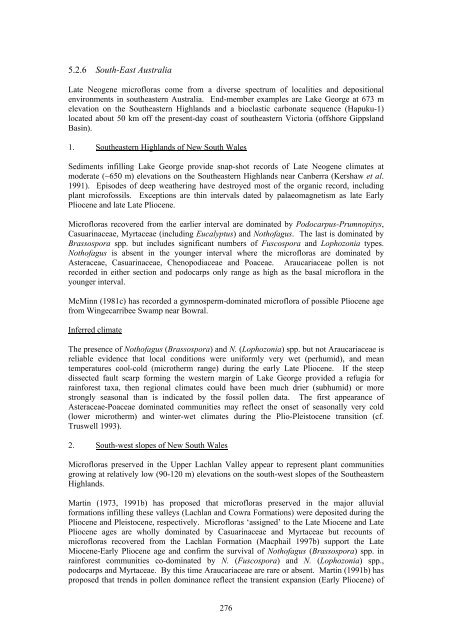OFR 151.pdf - CRC LEME
OFR 151.pdf - CRC LEME
OFR 151.pdf - CRC LEME
You also want an ePaper? Increase the reach of your titles
YUMPU automatically turns print PDFs into web optimized ePapers that Google loves.
5.2.6 South-East Australia<br />
Late Neogene microfloras come from a diverse spectrum of localities and depositional<br />
environments in southeastern Australia. End-member examples are Lake George at 673 m<br />
elevation on the Southeastern Highlands and a bioclastic carbonate sequence (Hapuku-1)<br />
located about 50 km off the present-day coast of southeastern Victoria (offshore Gippsland<br />
Basin).<br />
1. Southeastern Highlands of New South Wales<br />
Sediments infilling Lake George provide snap-shot records of Late Neogene climates at<br />
moderate (~650 m) elevations on the Southeastern Highlands near Canberra (Kershaw et al.<br />
1991). Episodes of deep weathering have destroyed most of the organic record, including<br />
plant microfossils. Exceptions are thin intervals dated by palaeomagnetism as late Early<br />
Pliocene and late Late Pliocene.<br />
Microfloras recovered from the earlier interval are dominated by Podocarpus-Prumnopitys,<br />
Casuarinaceae, Myrtaceae (including Eucalyptus) and Nothofagus. The last is dominated by<br />
Brassospora spp. but includes significant numbers of Fuscospora and Lophozonia types.<br />
Nothofagus is absent in the younger interval where the microfloras are dominated by<br />
Asteraceae, Casuarinaceae, Chenopodiaceae and Poaceae. Araucariaceae pollen is not<br />
recorded in either section and podocarps only range as high as the basal microflora in the<br />
younger interval.<br />
McMinn (1981c) has recorded a gymnosperm-dominated microflora of possible Pliocene age<br />
from Wingecarribee Swamp near Bowral.<br />
Inferred climate<br />
The presence of Nothofagus (Brassospora) and N. (Lophozonia) spp. but not Araucariaceae is<br />
reliable evidence that local conditions were uniformly very wet (perhumid), and mean<br />
temperatures cool-cold (microtherm range) during the early Late Pliocene. If the steep<br />
dissected fault scarp forming the western margin of Lake George provided a refugia for<br />
rainforest taxa, then regional climates could have been much drier (subhumid) or more<br />
strongly seasonal than is indicated by the fossil pollen data. The first appearance of<br />
Asteraceae-Poaceae dominated communities may reflect the onset of seasonally very cold<br />
(lower microtherm) and winter-wet climates during the Plio-Pleistocene transition (cf.<br />
Truswell 1993).<br />
2. South-west slopes of New South Wales<br />
Microfloras preserved in the Upper Lachlan Valley appear to represent plant communities<br />
growing at relatively low (90-120 m) elevations on the south-west slopes of the Southeastern<br />
Highlands.<br />
Martin (1973, 1991b) has proposed that microfloras preserved in the major alluvial<br />
formations infilling these valleys (Lachlan and Cowra Formations) were deposited during the<br />
Pliocene and Pleistocene, respectively. Microfloras ‘assigned’ to the Late Miocene and Late<br />
Pliocene ages are wholly dominated by Casuarinaceae and Myrtaceae but recounts of<br />
microfloras recovered from the Lachlan Formation (Macphail 1997b) support the Late<br />
Miocene-Early Pliocene age and confirm the survival of Nothofagus (Brassospora) spp. in<br />
rainforest communities co-dominated by N. (Fuscospora) and N. (Lophozonia) spp.,<br />
podocarps and Myrtaceae. By this time Araucariaceae are rare or absent. Martin (1991b) has<br />
proposed that trends in pollen dominance reflect the transient expansion (Early Pliocene) of<br />
276

















